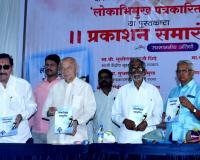- India
- Digital Journalism Can Only Secure the Future of Journalism
Digital Journalism Can Only Secure the Future of Journalism
Pratiti Dhang Kolkata : One of the speakers who stole the limelight on the first day of #MediaNext 2020 that focused on Digital Journalism was Ashutosh, deemed by many as one of the best Hindi language journalists in the country. #MediaNext 2020 is being organized by the Kolkata-based Adamas University in association with Sharda University, Birla

Pratiti Dhang
Kolkata : One of the speakers who stole the limelight on the first day of #MediaNext 2020 that focused on Digital Journalism was Ashutosh, deemed by many as one of the best Hindi language journalists in the country.
#MediaNext 2020 is being organized by the Kolkata-based Adamas University in association with Sharda University, Birla Global University, DME, AIMEC, Lok Samvad Sansthan, exchange4media, ABP Education and IndiaReal. The mega conclave is being organized over a period of 10 days from June 1, 2020 to June 10, 2020. Each day of the conclave focuses on one specialized domain of the Media and Entertainment (M&E) industry and the impact of the Covid-19 pandemic on that specific domain.
After getting huge success as Managing Editor of IBN7 from 2006 to 2014, and a brief break in politics, Ashutosh is again back to journalism. Currently, he is the founder and editor of the Satya Hindi and is one of the iconic faces of journalism, both in television and the digital media. He’s a prolific writer, reputed columnist, and a powerful debater. Ashutosh has authored three critically acclaimed books – Hindu Rashtra, Anna: 13 Days That Awakened India, and The Crown Prince, the Gladiator and the Hope: Battle of Change.
“The world we are living in today, and the kind of journalism we practice today, is incredible,” Ashutosh initiated the session by saying this. He acknowledged the current pandemic scenario and how it has led to panic in the minds of the individuals. He addressed about how the technology and the digital medium has kept us all of us connected together.
Ashutosh is one of the reputed journalists, who started his career in print journalism. Then he shifted to the broadcasting news industry and worked as a first-generation TV journalist. And currently, he is in the digital media. It has been a really long journey for him. But, for the last two years, it has been really a challenging task for him to work on the digital platform at this age. He still finds it difficult to know all the technical norms, but he is adapting to it. He said, “This revolution might not seem revolutionary to this generation and, the millennial might not understand it.”
His Journey from Print Media to Digital Media
He talked about the difference between the two eras of journalism – now and then, by his own personal experience. “Some years back during the Punjab Legislative Assembly election, I was sent to report at Jalandhar. It was a Sunday, and I had to file my report. During those days, I didn’t have a cell phone. There were no Public Call Offices (PCOs) during that time too. The only way to send the report was to FAX it from the Post Office”, said Ashutosh.
He further narrated the incident and said, “I collected all the information from the source, and prepared a report. I wrote it down on paper and went to the Post Office. But the official denied to send it as it was written in blue ink when it was supposed to be written in black. So, I took a blank inked pen and wrote the report again. It took around three hours to send me the report.”
After sharing his experience, he explained the webinar attendees about the current condition. “Now, even if I have to travel to some other place, and also have to report an incident, I can simply type it down on my phone. I ask someone else to drive and prepare the report. It hardly takes hardly one and a half hours to complete and submit it”, said the editor. “Now, everything is instant”, he added.
Ashutosh believes that the changes brought in the last 30 years, not only in India but all over the worldwide are revolutionary. Even in the case of reporting, there have been a lot of changes that took place over the years. “We had to go to the library, get the cutting of the published newspapers, and then take down notes. After that, we travelled back to our home and then prepare the report. During those days, one report took even one day. But now, you all can get the information from your smartphones by googling.”
“Newspapers like The New York Times, Washington Post, The Wall Street Journal and The Economist, was sold once in a week, in Delhi. People used to buy them and read them after a week or so. If I was in Mirzapur, it took two to three days to reach me. But now you can read them instantly on your smartphones”, said Ashutosh from his personal experience.
Journalism – What Does It Mean Today and, What Is Its Future?
The attention of the webinar attendees was brought to the current scenario of journalism, by the editor. He believes that eternity and the availability of content is only because of digital technology. Journalism has been brought to the common people, from the elite club, and now everyone is a reporter. “From 1,000 journalists, the number has been brought to around 137 crores in India. Everyone is a journalist today”, he said. In today’s world, one can report it from home or may go to the field. He stated that only the strong information and reports will be accepted by the readers.
He emphasized how the print media is fainting, with the rise of digital media. After the pandemic broke out, he realized that print is on the death bed. The only difference that lies is previously, people could feel and smell the essence of paper, but now all we need to do is scroll up the screen on our smartphones. And, it’s not the print, but even televisions have started declining. He believes that in the near future, both print and television are going to get merged in the form of digital media.
“Digital journalism can only secure the future of journalism”, said Ashutosh. “Now no big television studio is required,” he further added.
Further, he briefed the attendees about the danger in journalism, by focusing on the word ‘journalism’ itself. According to him, journalism is a method of processing information. After, gathering the information, it goes through a lot of cuts and edits, to make it presentable. The entire process is referred to as ‘journalism.
“Today, everyone is a journalist, but how much credible are they?” asked the audience. But these days, the information collected doesn’t go through any processing. People need to understand which information is coming to us after being processed, and they can trust them. Only a few will have authenticity.
People these days even have the opportunity to express their own views by creating their own platforms. Sometimes, people can’t voice their opinions on print and television, due to the government. But digital media provides us that space. He also lighted up the disadvantages of digital media such as blackmailing and manipulating, but it’s the people who need to identify them.
“A journalist is a person who has the ability to process the raw information, and keep in mind that the information provided is authentic,” says Ashutosh.
The concluded with a Question and Answer round, where he was asked about independent journalism. He answered, “There has been a lot of discussion going on in both Indian and international level. Even television journalism is not independent, and that’s true. Many renowned journalists considered Indian journalism as North Korean journalism today”.
ooo












